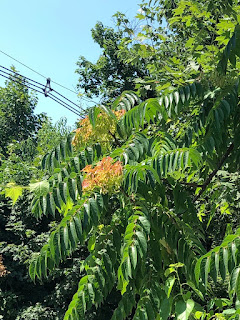What's Happening in December?
Again this month there is little color around the campus. The holly berries are still present, both gold and red. We were assured that these are the friendly American hollies. Remember there are the scattered male hollies without berries but essential to the display.
There was a question about evergreen and conifers. Making the point that not all conifers are evergreen, we have larch, bald cypress, and dawn redwoods in the area that shed their needles. And not all evergreens are conifers as we see near the Y with the English ivy and the Hollies. But the specific question was " is grass evergreen?" Online I do not see any of the grasses among species listed as evergreen at least in this area. Let's watch the grass over the winter.
One grass expert in the family raises and sells hay. Keeps up to date at an Ohio State extension course every summer. The course is known as "Hay U". He says that despite the green appearance of the late fall grass it has lost its nutrition and he has to supplement the few remaining cow's feed. The shorter days and colder nights reduce the sugar in the grass. This is going on through out the Y campus as all the plants switch more to respiration and less to photosynthesis. The northern hemisphere trees are exhaling carbon dioxide and taking up oxygen. The CO2 in the air gets slightly higher.
The grass-evergreen question was more about the ground cover than specific as to grass and that gets more complicated. If I find a consultant we might look close up at the "turf". It is a whole world in itself. Do the deer still graze the campus during the winter? Where to the deer get supplemental nutrition. Other species in the "grass" like creeping Charlie must also lose their nutrients.
The carbon balance in the evergreens would be interesting, and surely data is available. They may gain a little sugar over the winter, or just have enough photosynthesis to be worth keeping the needles till spring. The next month we might look closer at the conifers. Not trying for specific species but put our trees into large groups. I think we have "firs" that are not firs and "cedars" that are not cedars.
The recent snow might be considered a happening. It does at least for the early risers let you trace the wildlife in the field. We got there late and bipedal footprints had obscured most of the surface. Here is one not so mysterious hoof print. We saw raccoon and fox prints near the house. Probably also at the Y but have to wait to next snowfall.




Comments
Post a Comment